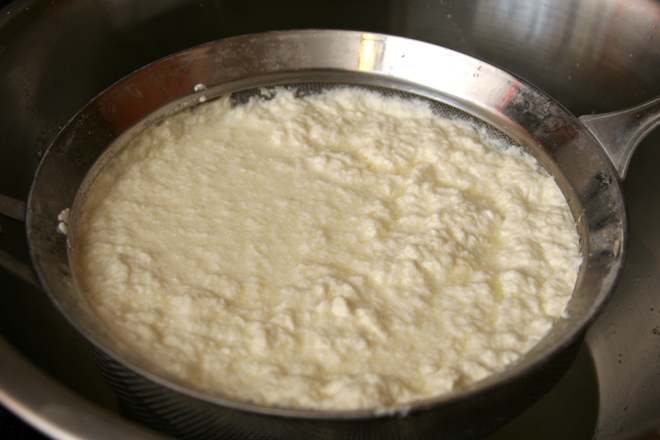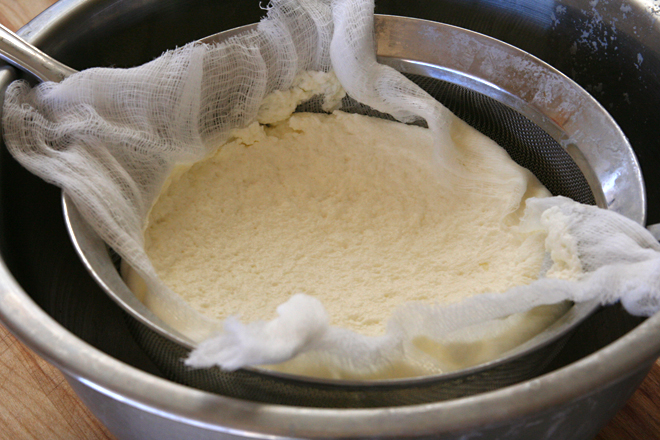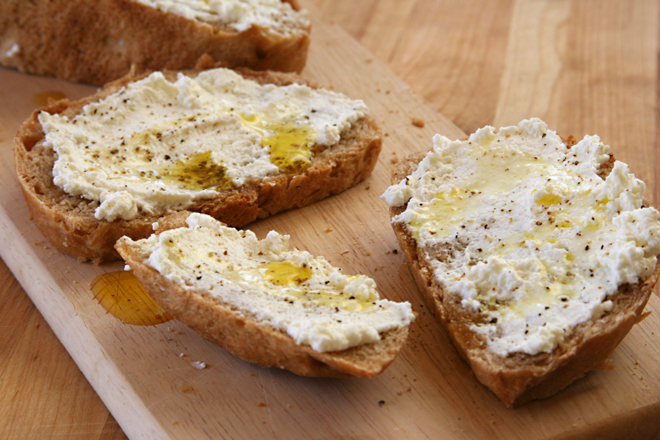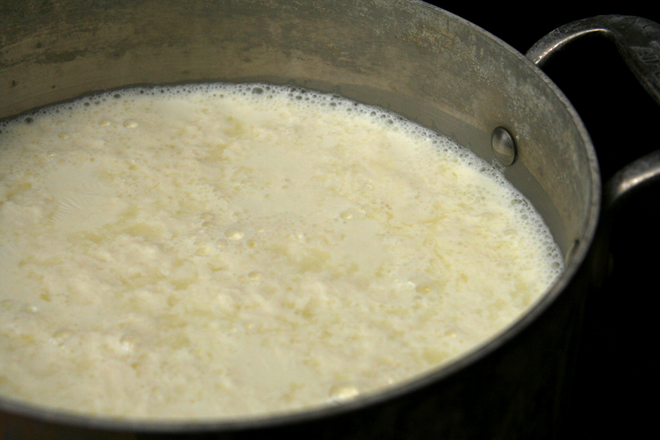Here are some things you need to know about making ricotta at home:
1) It really is as easy as they say. The process involves nothing more than heating milk and salt, stirring in lemon juice or vinegar, and straining the mixture.
2) It requires a lot of milk for a relatively small amount of cheese – you’ll start with about four times more volume of milk than you’ll end up with of cheese.
3) About that milk – you can use the regular ol’ stuff from the grocery store, ultrapasteurization and all. That’s all I have access to, and I’ve made some nice ricotta with it.
4) If you’re feeling decadent, you can substitute some of the milk with cream. I started out using about seven times more milk than cream, but in the pictures you see here, I was almost out of cream and used about twenty times more milk than cream. I like this batch just as much as the others.
5) You can use either regular white vinegar or lemon juice. I read here that using all lemon juice gives the cheese a lemony flavor and vinegar is more neutral. However, I was worried about my cheese tasting like vinegar, which would be gross, so I always use a mixture of the two.

after 5 minutes of straining with no cheesecloth or paper towel liner
6) The pH of the acid you add to curdle the milk matters. That’s one reason vinegar is more dependable than lemon juice; the acidity of lemons varies. It also means you can’t substitute other vinegars, because they might not be as acidic as white vinegar. I learned this the hard way when I realized I was out of regular vinegar and tried to use white wine vinegar instead; the milk didn’t form many curds.

after 15 minutes of straining with no cheesecloth or paper towel liner
7) You don’t need cheesecloth. The first two times I made this cheese, I strained the mixture in my fine-mesh strainer. Worried that I was losing too much of good stuff, I tried using a double layer of paper towels, but it was draining too slowly and I got impatient and went back to just the strainer. That being said, I really am trying to remember to buy cheesecloth.

after 15 minutes of straining with no liner, stirred
8 ) You’ll feel wasteful throwing all that whey down the drain, but the bit of internet research I did indicated that it isn’t good for bread dough, because the acid breaks the gluten molecules, weakening the dough’s structure.
9) It isn’t technically ricotta, which is made from the whey leftover from making other cheeses. (The word ricotta, in Italian, means re-cooked.) When I first heard this, I wondered why anyone would call it ricotta, since it isn’t made the same way. Then I made it myself and realized that it looks and tastes just like real ricotta.

after 2 hours of straining with no liner
10) Homemade ricotta is better than the stabilizer-filled tubs you’ll find in most grocery stores. However, if you do happen to have access to real fresh ricotta, it’s probably cheaper to buy that rather than using half a gallon of milk to make 2 cups of cheese. As for which is better, the last time I bought fresh ricotta from an Italian market was a couple years ago, too long to remember the details of how good it was. I know it was really good, but I know this is really good too.

finally bought cheesecloth; after 1 hour of straining with double layer of cheesecloth; smoother, creamier cheese
One year ago: Beef Short Ribs Braised in Tomato Sauce
Two years ago: Maple Oatmeal Scones
Three years ago: Chopped Salad
Four years ago: Country Crust Bread
Printer Friendly Recipe
Ricotta (adapted from Smitten Kitchen and Serious Eats)
Makes about 1 cup
You can adjust the amount of cream down (to 4 cups milk and no cream) or up (to 3 cups milk and 1 cup cream), depending on how rich you want the ricotta to be.
3½ cups whole milk
½ cup heavy cream
½ teaspoon salt
2 tablespoons white vinegar
1 tablespoon lemon juice
1. In a 2-quart saucepan over medium-high heat, heat the milk, cream, and salt to 190 degrees. Remove the pot from the heat, add the vinegar and lemon juice, stir once, and set aside for 5 minutes.
2. Place a fine-mesh strainer over a large bowl. Line the strainer with a double layer of cheesecloth or a single layer of paper towels. Pour the curdled milk mixture into the strainer. Set aside for about an hour. It will get thicker the longer it sits to drain.










I love homemade ricotta, but instead of forgetting to buy cheesecloth, I always forget to buy milk, which definitely puts a damper on things. When I do remember, though, I save the whey and water my plants with it– last year I swear that’s what made my basil go NUTS. I doubt they’d love it every day, but I watered my herbs once a week with the whey and it seemed to be a great plant supplement.
FINALLY! I’ve really struggled with ricotta in the past. Which is so odd, because it seems so easy. I see you used vinegar and lemon juice which makes total sense to me. The recipes that have failed me have been one or the other.
Can’t wait to try it.
I’m a little bit weirded out because, to be honest, from these pictures I swear you made this in my kitchen. I have that pot. I feel like I have that spoon (it came with my husband’s deep fryer) and I definitely have that strainer.
I’ve made this type of cheese a couple of times. It is better than grocery store stuff in the tub because that stuff most often simply seems to add texture to recipes rather than flavor.
Leanne – I just looked it up, and it turns out that I can compost the whey! Awesome!
I was just reading about making my own ricotta and I clicked on your blog link – coincidence? I think not! I have been wanting to make a veggie lasagna with fresh ricotta… and possibly have a nice breakfast with ricotta drizzled with honey on toast. This will have to be a project of mine in the next few weeks. Thanks so much for the detailed recipe and perfect pictures!
Tasha
How long can you keep this homemade ricotta for??
I would love to make this with my kids – what a blast they would have making their own cheese
Coleene
Coleene – The Serious Eats recipe says it can be stored in the fridge for up to 5 days. So far, I’ve personally only kept it around for 2 days.
Sounds like a fun little project!
I have made this ricotta very creamy, loved it. Served with penne and some grilled asparagus.
Hmmm…I think I will have to give this recipe a try. I’ve made a fresh mozzarella that is similar to this recipe, except that it calls for rennet (vegetarian rennet these days). Mozzarella is another great cheese to make with kids.
I’ve gotten into making my own cheese and it’s been very rewarding thus far (except that first ricotta). And actually, given the price of good hard cheese and the price of milk, there’s not that much of a price difference between buying and making. Plus it’s so cool to see your little cheese wheels aging in their chipper wax coats. New England Cheese Making Supply is an excellent source for all things cheese.
Thank you sooo much for this lovely post! Just today I bought ricotta for a lunch meal, but having read your recipe, I’m definitely gonna try to make it very soon.
This recipe is definitely a winner-a perfect ten. The vinegar in this preparation is what makes the milk form curds. If there is too little vinegar, the curds will not fully form and you will get a smaller yield. If there is too much vinegar, you will get an acidic tasting ricotta. Accordingly, the vinegar should not exceed 5 percent of the volume of moisture.
Looks yummy! By the way, if you need any cheesecloth, let me know and I may be able to send you some free of charge.
Don’t throw out or compost that whey – it is far too valuable. It can be used in the soaking water for grains like brown rice or your breakfast oats to make them more digestible and nutritious; it can be added to homemade ketchup or mayonnaise to ferment them and add to the nutrition and shelf life. Look up whey and traditional foods – there is plenty more you can do with it.
PS – has anyone tried freezing the ricotta?
I found this recipe a couple weeks ago and have made it a couple times now…my usual litmus test (if it’s good twice, it’ll always be good), and it’s delicious. I use just vinegar with no bad taste at all. My daughter and I are going to have a cheese making party with some of the grandkids! and use this recipe. Thanks for posting it.
I noticed a comment about being able to send cheese cloth. We are stationed in Japan and I can’t seem to find it. We have an APO address so it would be like sending something stateside.